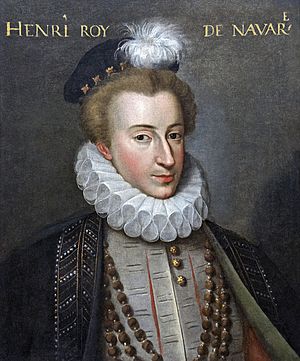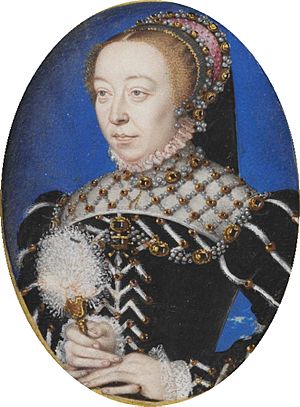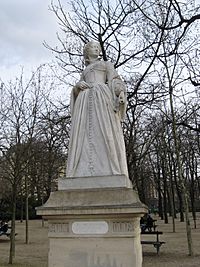Jeanne d'Albret facts for kids
Quick facts for kids Jeanne III |
|
|---|---|

Portrait by François Clouet, 1570
|
|
| Queen of Navarre | |
| Reign | 25 May 1555 – 9 June 1572 |
| Coronation | 18 August 1555 at Pau |
| Predecessor | Henry II |
| Successor | Henry III |
| Born | 16 November 1528 Saint-Germain-en-Laye, Kingdom of France |
| Died | 9 June 1572 (aged 43) Paris, Kingdom of France |
| Burial | Ducal Church of collégiale Saint-Georges, Vendôme |
| Spouse |
William, Duke of Jülich-Cleves-Berg
(m. 1541; annulled 1545) |
| Issue | |
| House | Albret |
| Father | Henry II of Navarre |
| Mother | Margaret of Angoulême |
| Religion | Reformed (Huguenot), prev. Roman Catholic |
| Signature | |
Jeanne d'Albret (also known as Jeanne III) was a powerful queen who ruled the Kingdom of Navarre from 1555 to 1572. She was born on November 16, 1528, and passed away on June 9, 1572.
Jeanne was the daughter of King Henry II of Navarre and Queen Margaret of Angoulême. She married twice. Her first marriage was to William, Duke of Jülich-Cleves-Berg, but it was later cancelled. Her second marriage was to Antoine de Bourbon. They had two children who survived to adulthood: Henry and Catherine.
When her father died in 1555, Jeanne and Antoine became the rulers of Navarre. They ruled together until Antoine died in 1562. Jeanne became a very important leader of the French Huguenots. Huguenots were French Protestants who followed the teachings of John Calvin. After she publicly became a Calvinist in 1560, she joined the Huguenot side in the French Wars of Religion.
Jeanne was a key figure in these wars. She became a leader in the Huguenot-controlled city of La Rochelle. She worked to make peace with the French queen mother, Catherine de' Medici. She also arranged for her son, Henry, to marry Catherine's daughter, Marguerite. Jeanne died suddenly in Paris. Her son, Henry, became King Henry III of Navarre. He later became the first Bourbon king of France, known as Henry IV.
Jeanne was the last active ruler of Navarre. Her son inherited her kingdom. However, because he was often leading the Huguenot forces, he asked his sister, Catherine, to govern Béarn. Catherine ruled for over twenty years. In 1620, Jeanne's grandson, Louis XIII, officially made Navarre part of the French crown.
Contents
Early Life and First Marriage
Jeanne was born on November 16, 1528, in the royal palace at Saint-Germain-en-Laye, France. Her parents were King Henry II of Navarre and Queen Marguerite of Angoulême. Her mother was also a talented writer.
From the age of two, Jeanne was raised away from her parents. Her uncle, King Francis I, took charge of her education. She grew up in the Château de Plessis-lez-Tours in the Loire Valley. She received an excellent education from a humanist teacher named Nicolas Bourbon.
Jeanne was described as a lively princess. She also showed early on that she could be very stubborn. When she was 12, in 1541, King Francis I arranged for her to marry William "the Rich," Duke of Jülich-Cleves-Berg. William was the brother of Anne of Cleves, who was one of Henry VIII's wives.
Jeanne did not want this marriage. She protested and even had to be carried to the altar. Before the wedding, she signed documents stating that she did not agree to the marriage. She was dressed in a beautiful golden crown and a skirt covered in jewels.
Four years later, the marriage was cancelled. This happened because the Duke of Cleves-Berg ended his alliance with France. The marriage was annulled because Jeanne had been forced into it against her will. She then stayed at the French royal court.
Second Marriage
After King Francis I died in 1547, Henry II became the new French king. Jeanne then married Antoine de Bourbon on October 20, 1548. This marriage was meant to strengthen land ownership in France.
Their marriage was described as a "romantic match."
Jeanne and Antoine had five children. However, only two of them lived to be adults: Henry and Catherine.
On May 25, 1555, Jeanne's father, Henry II of Navarre, passed away. Jeanne and her husband Antoine then became the joint rulers of Navarre. When she became queen, she inherited a kingdom that included Lower Navarre, Soule, and the principality of Béarn.
On August 18, 1555, Jeanne and Antoine were crowned together in Pau. A special coin was made to celebrate their new reign. It said in Latin: "Antoine and Jeanne, by the grace of God, monarchs of Navarre and lords of Béarn." Antoine was often away, so Jeanne was left to rule Béarn alone. She managed her household and kingdom with a strong hand.
Jeanne was influenced by her mother, who had supported religious reform and new ideas. This led Jeanne to become a Calvinist. In her first year as queen, she held a meeting with Protestant ministers. On Christmas Day 1560, she publicly announced her conversion to Calvinism. This made her the highest-ranking Protestant in France. She became an opponent of the Catholic Church's efforts to stop the Protestant Reformation.
After making Calvinism the official religion of her kingdom, Jeanne removed priests and nuns. She also had Catholic churches destroyed and Catholic ceremonies banned. She ordered the New Testament to be translated into Basque and Béarnese for her people.
Jeanne was described as small and slender, but very upright. She had a narrow face, cold, still eyes, and thin lips. She was very smart, but also strict and self-righteous. Her way of speaking could be sharp and sarcastic. A Huguenot writer, Agrippa d'Aubigné, said Jeanne had "a mind powerful enough to guide the highest affairs."
Besides her religious changes, Jeanne also worked to improve her kingdom. She made lasting changes to its economic and legal systems.
In 1561, Catherine de' Medici, who was ruling France for her young son King Charles IX, appointed Antoine as a top general. Jeanne and Catherine had met before at court. Jeanne reportedly did not like Catherine, calling her the "Florentine grocer's daughter."
French Wars of Religion
The struggle for power between Catholics and Huguenots in France led to the French Wars of Religion in 1562. Jeanne and Antoine were at court when Antoine decided to support the Catholic side. He even threatened to divorce Jeanne if she refused to attend Catholic Mass. Catherine de' Medici tried to get Jeanne to obey her husband for peace, but Jeanne refused. She firmly stood by her Calvinist faith and continued to hold Protestant services in her own rooms.
Many other nobles joined the Catholic side. Fearing her husband's and Catherine's anger, Jeanne left Paris in March 1562. She traveled south to find safety in Béarn.
During her journey, Jeanne stopped at her husband's castle in Vendôme. She could not stop a group of 400 Huguenots from attacking the town. They robbed churches, mistreated people, and looted the ducal chapel where Antoine's ancestors were buried. Because of this, her husband became very angry with her. He ordered his general to arrest her and send her to a Catholic convent in Paris. Jeanne continued her journey and managed to escape before she could be captured.
Later that year, Antoine was badly wounded during a battle at Rouen. He died before Jeanne could reach him. From then on, Jeanne ruled Navarre as the sole queen. Her son, Henry, became the "first prince of the blood." Jeanne often took him with her as she traveled through her lands to manage government affairs. Philip II of Spain offered to marry Jeanne to his son if she returned to Catholicism, but she refused.
At first, Jeanne tried to stay neutral in the conflicts. She focused on defending Navarre, which was next to Catholic Spain. The Pope sent envoys to try to convince her to return to Catholicism. Jeanne replied that "the authority of the Pope's legate is not recognised in Béarn." At one point, there was a plan by Pope Pius IV to kidnap her and send her to the Spanish Inquisition. This would have allowed France and Spain to take over Navarre. Jeanne was even called to Rome to be judged for heresy.
This threat worried King Philip II. Catherine de' Medici was also angered by the Pope's interference in French affairs. She sent angry letters to the Pope. The threats never happened. Jeanne met with Catherine de' Medici in 1564 and 1565 to discuss matters.
Third War

When the third religious war began in 1568, Jeanne decided to actively support the Huguenot cause. Feeling unsafe from French Catholic and Spanish troops, Jeanne and Henry found refuge in the Protestant stronghold of La Rochelle.
As a leader, Jeanne wrote messages and letters to other rulers asking for their help. She imagined the region of Guyenne as a "Protestant homeland." She played a major role in military actions from 1569 to 1570 to make this dream come true.
In La Rochelle, she took charge of defenses, money, and gathering information. She also made sure people followed rules. She used her own jewelry to get a loan from Elizabeth I of England. She also looked after the many refugees who came to La Rochelle for safety. She often went with Admiral de Coligny to the battlefield. Together, they checked defenses and encouraged the Huguenot soldiers. She also started a religious school in La Rochelle, attracting many learned Huguenot men.
After the Huguenot defeat at the Battle of Jarnac on March 16, 1569, Jeanne's brother-in-law, Louis, was captured and killed. Gaspard de Coligny then took command of the Huguenot forces. He led them on behalf of Jeanne's son Henry and Condé's son. Jeanne arranged a loan of 20,000 livres from England, using her jewels as security for the Huguenot cause.
Peace of Saint-Germain-en-Laye

Jeanne was key in negotiating the Peace of Saint-Germain-en-Laye. This treaty ended the "third war" in August 1570 because the Catholic army ran out of money. As part of the peace treaty, a marriage was arranged between Jeanne's son and King Charles IX's sister, Marguerite. Jeanne reluctantly agreed to this marriage. In return, Huguenots were allowed to hold public office in France, which they had not been able to do before. Despite her distrust of Catherine de' Medici, Jeanne accepted Catherine's invitation to meet and discuss the marriage.
Jeanne took her daughter Catherine with her to Chenonceaux on February 14, 1572. There, the two powerful women from opposing sides met. Jeanne found the atmosphere at Chenonceaux to be unpleasant. She wrote letters to her son criticizing the young women at Catherine's court.
Jeanne also complained to her son that Catherine de' Medici treated her badly during negotiations. On March 8, she wrote that Catherine "treats me so shamefully that you might say that the patience I manage to maintain surpasses that of Griselda herself."
Death
The two women reached an agreement. Jeanne left Catherine de' Medici after the marriage contract between Henry and Marguerite was signed on April 11. She moved to Paris and went on daily shopping trips to prepare for the wedding. Anna d'Este described Jeanne during this time as "not in very good health but very courageous. She is wearing more pearls than ever."
On June 4, 1572, two months before the wedding, Jeanne returned home feeling ill. The next morning, she woke up with a fever and pain in her upper right side. Five days later, she died. A rumor quickly spread that Catherine de' Medici had poisoned Jeanne. The rumor claimed Catherine sent her a pair of poisoned perfumed gloves from her perfumer. This story appears in books and plays, like Alexandre Dumas's novel La Reine Margot. However, an autopsy showed that Jeanne died of natural causes.
After her funeral, her body was taken through the streets of Vendôme. She was buried next to her husband at the Ducal Church of collégiale Saint-Georges. These tombs were destroyed during the French Revolution in 1793. Her son Henry became King Henry III of Navarre. In 1589, he became King Henry IV of France, starting the Bourbon line of kings.
Writings
Like her mother, Jeanne was a skilled writer and enjoyed writing poetry. She also wrote her memoirs, which explained and defended her actions as a leader of the Huguenots.
Titles and Roles
Jeanne held many important titles during her life:
Titles by Birth
- Queen of Navarre (1555–1572)
- Duchess of Albret (1555–1572)
- Countess of Limoges (1555–1572)
- Countess of Foix (1555–1572)
- Countess of Armagnac (1555–1572)
- Countess of Bigorre (1555–1572)
- Countess of Périgord (1555–1572)
- Co-Princess of Andorra (1555–1572)
Titles by Marriage
- Duchess of Jülich-Cleves-Berg (1541–1545)
- Duchess of Vendôme (1550–1562)
- Duchess of Beaumont (1550–1562)
- Countess of Marle (1548–1562)
- Countess of La Fère (1548–1562)
- Countess of Soissons (1550–1562)
Marriages and Children
In 1541, Jeanne married William, Duke of Jülich-Berg-Ravensberg-Kleve-Mark. This marriage was annulled in 1545, and they had no children.
On October 20, 1548, she married Antoine de Bourbon, Duke of Vendôme. They had five children:
- Henri de Bourbon, Duke of Beaumont (1551–1553)
- Henri de Bourbon (Henry III of Navarre and IV of France) (December 13, 1553 – May 14, 1610). He married Margaret of Valois but had no children with her. He later remarried Marie de' Medici in 1600 and had children.
- Louis Charles de Bourbon, Count of Marle (1555–1557)
- Madeleine de Bourbon (1556-1556)
- Catherine de Bourbon (February 7, 1559 – February 13, 1604), also known as Catherine of Navarre. She married Henry, Hereditary Prince of Lorraine in 1599.
Images for kids
See also
 In Spanish: Juana de Albret para niños
In Spanish: Juana de Albret para niños




